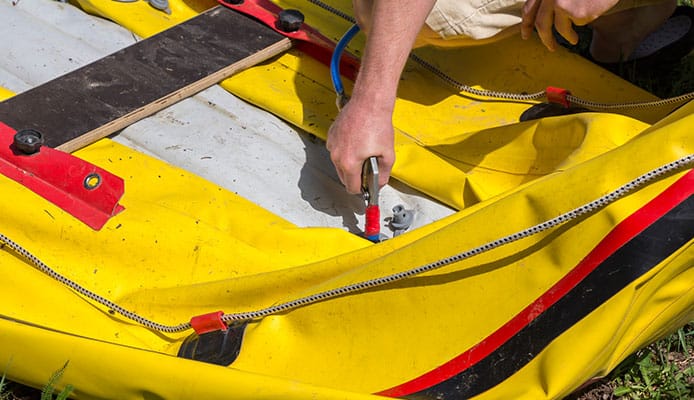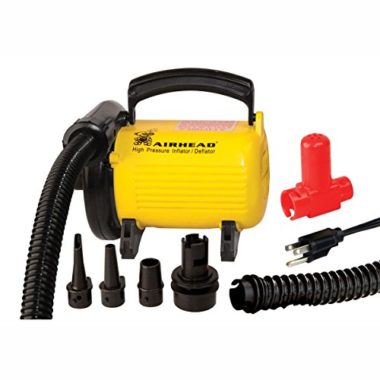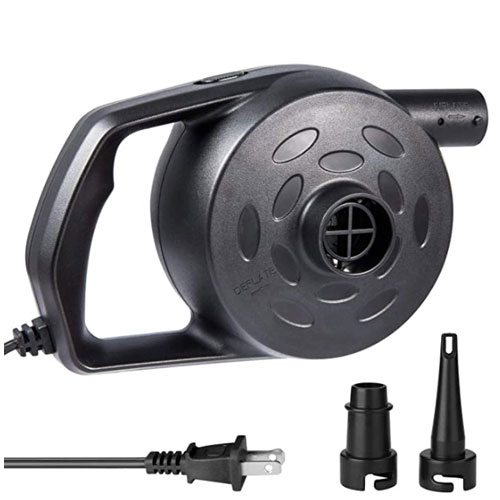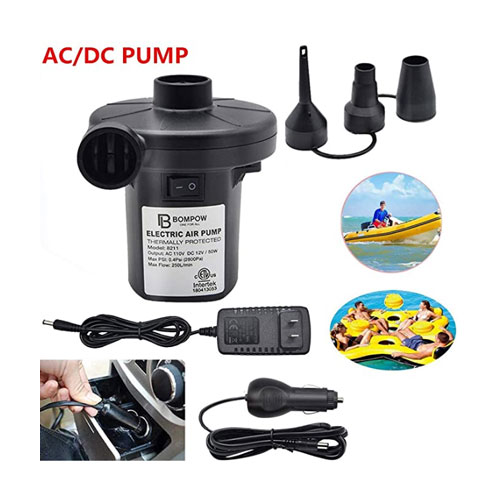
While inflatable kayaks and SUPs offer countless benefits when it comes to transportation and storage, one of their downsides is that you need to inflate them once you reach the water. If you’re tired of using a manual pump and having sore arms every time, perhaps it’s time you bought an electric pump.
When choosing a pump, you should consider four things – power supply, valve compatibility, airflow, and max pressure. To help you find the right pump, this article will take a closer look at all the best electric pumps for sup on the market and compare their performance in these key areas.
OUR TOP PICK
AGPtEK Quick-Fill Electric Air
- Stand Out Features - Why We Love It
- Compact pump design with simple on/off operation
- Designed for both inflating and deflating your gear
- Three nozzles cover most standard valve sizes and types
- Two types of power cables included (outlet and car plug)
Power: 50W
Pressure: 0.5 PSI
Voltage: 110V AC (Power Outlet), 12V DC (Lighter Plug)
Cord Length: 5.2 feet (Home Adapter), 8.2 feet (Car Adapter)
Nozzle Size(s): 0.23in (S), 0.66in (M), 0.9in (L)
EDITORS CHOICE
Etekcity High Power Air
- Stand Out Features - Why We Love It
- Powerful output (250W) for reliable performance
- One of the quietest pumps on the market
- Very high airflow (up to 600 L/min)
- Wide and comfortable carry handle
Power: 250W
Pressure: 1.2 PSI
Voltage: 110-120V
Cord Length: 5.3 feet
Nozzle Size(s): 0.24in (S), 0.67 (L)
Airflow: 21.2 CFM (Cubic Feet Per Minute)
BOMPOW 50W
- Stand Out Features - Why We Love It
- Compact design that is easy to take with you
- Three types of nozzles fit most inflatable objects
- Vents on the bottom so it doesn’t overheat
- Made of extra-durable ABS plastic
Power: 50W
Pressure: 0.4 PSI
Voltage: 110V AC (Power Outlet), 12V DC (Lighter Plug)
Cord Length: 5.9 feet
Nozzle Size(s): 0.29in (S), 0.69in (M), 0.91in (L)
Airflow: 100 L/min (S), 200 L/min (M), 250 L/min (L)
Coleman Quickpump 120V

- Stand Out Features - Why We Love It
- Excellent compatibility with all larger inflatables
- Equipped with a Double Lock/Boston Valve adapter
- Requires 120V AC to operate (wall outlet)
- Covered by a 1-year manufacturer’s warranty
Power: 235W
Voltage: 120V AC
Cord Length: 6 feet
Hose Length: 3.5 feet
Nozzle: Double Lock/Boston Valve
- Stand Out Features - Why We Love It
- Impressive maximum pressure (up to 15 PSI)
- Display for setting and tracking the desired inflation
- Allows you to choose between different pressure units (PSI, kPa, and mbar)
- Compatible with Boston, double lock, mini-double lock, and pinch valves
Pressure: 15 PSI
Voltage: 12 DC (Lighter Plug)
Cord Length: 16 feet
Nozzle(s): Multiple Adapters
Airflow: 190 L/min
Sanipoe Two-Way Electric
Sanipoe Two-Way Electric
- Stand Out Features - Why We Love It
- Dual power supply (wall outlet or car plug)
- Reverse switch for deflating your SUP
- Very good airflow considering the size
- 1-month money-back and 6-month replacement warranty
Power: 50-60W
Pressure: 0.58 to 0.87 PSI
Voltage: 110V AC (Power Outlet), 12V DC (Lighter Plug)
Cord Length: 5.83 feet
Nozzle Size(s): S, M, L (Universal)
Airflow: 450 L/min (15.9 CFM)
Airhead Hi Pressure Air

- Stand Out Features - Why We Love It
- Exclusive screw-on Boston Valve adapter
- Accordion-style extension hose included
- Long 10-foot power cord for easier use
- High air volume for fast inflation (460L/min)
Power: 730W
Pressure: 2.5 PSI
Voltage: 120V AC
Cord Length: 10 feet
Nozzle(s): Four Universal Fittings (Including a Boston Valve Adapter)
Airflow: 460 L/min
Seamax SUP20S Pro Electric
- Stand Out Features - Why We Love It
- Highest inflation pressure (up to 20 PSI)
- Display and buttons for adjusting the pressure
- Digital sensor for preventing over-inflation
- Covered by a 2-year manufacturer’s warranty
Power: 120W
Pressure: 20 PSI
Voltage: 11-13V
Power Cord Length: 9 feet
Hose Length: 4.5 feet
Nozzle(s): Five Universal
How To Choose An Inflatable Sup And Kayak Electric Pump – Buying Guide

Power Source
Since the entire point of having an inflatable vessel is to make transportation easier, the electric pump you buy has to be mobile too. Of course, they need a power source to be operational, and there are several options. Some are connected to the lighter plug in your car, while others are connected directly to a car battery.
You might also like: How to Store Your Stand Up Paddle Board
If you are running the pump on your car battery, you should consider leaving the car running. This way you can be sure that the battery will have some power left while also making the pump more efficient.
Besides car batteries, many models even use a classic power outlet. This type of pump is often very powerful, but the downside is that you can’t use them anywhere you want. Perhaps the best option is to get a model that works with both car plugs and wall outlets.
Valve Compatibility
To make inflating easy and straightforward, always look for an electric pump that is compatible with the valve on your kayak or SUP. Most often the inflatables come with a Halkey-Roberts valve (also called H3, HR, or H-valve), but sometimes you can also get a Boston or military valve instead.
These high-pressure valves require special adapters to inflate, and the best thing you can do is immediately buy a compatible pump. Furthermore, many electric air pumps come with several different adapters, which can be useful if you own several different inflatable watercraft.
Also, it’s not a bad idea to have a manual pump with you as a backup. Unlike an electric pump, you can put this one in your kayak and take it with you in case you need it.
Related Review: Kayak Bilge Pump
Type of Pump
When it comes to design, you can either have a single-stage or a two-stage air inflow electric pump. Single-stage inflow pumps have constant air input, from beginning to the end. This is perhaps less efficient, because it may become slower near the end when the resistance is very high.
On the other hand, a two-stage inflow pump functions differently at the beginning (high inflow) and near the end (high pressure). This is usually a faster and more efficient method.
Some pumps are designed so that they also have reverse mode, which is used for deflating your vessel. Also, a smaller number of products have a pressure gauge to check if your vessel is optimally inflated, and automatic shut-off function when the desired pressure is reached.
Related Review: Air Pump For Inflatables
Ease of Use
Your new pump should be compact and lightweight, so it’s convenient to take with you. Some products come with a carry bag that makes it even more convenient to carry and protects the pump from damage and dirt. Finally, make sure that both the power cord and the air hose have sufficient length so the pump is easy to use.
Airflow and Pressure
When choosing an electric pump, airflow and pressure are the two performance parameters that you need to consider. A single-stage air pump for inflatables can’t be good at both – it either pumps a high number of liters per minute but can’t build up pressure, or it builds up the pressure but takes a very long time to inflate the board.
If you want a pump that can do both, you should look for a two-stage model. Unfortunately, these can be very expensive and set you back a few hundreds of dollars.
FAQs

Q: How Long Does An Electric Pump Take To Inflate A Stand-Up Paddleboard?
Two things determine this – the power of your pump and the size of the SUP. While the inflation time varies, it’s usually somewhere around 10 minutes. On average, an electric pump will produce 1 PSI per minute which is almost twice as fast compared to manual pumps.
Related Post: How To Inflate Paddle Board
Q: Can I Over-Inflate My Watercraft With An Electric Pump?
This is very unlikely to happen, but it is theoretically possible. Inflatable vessels are made to be very tough, meaning that the maximum pressure they can endure is much larger than the operational pressure instructed in the manual. So, there is a very slim chance that over-inflation will happen and cause damage to your watercraft.
To make this even harder to happen, most good electric air pumps come with a pressure gauge and automatic shut-off function, making sure that you are always within range the manufacturer specified. Over-inflation can perhaps only be a problem if you use your pump for inflatable with certain water toys.
Q: To What PSI Should I Inflate My SUP Board?
You will usually get a manual with your product, which is going to contain information on how much to inflate your SUP or kayak. For most products, the recommended range is somewhere between 10 and 15 PSI. Many of the pumps we’ve reviewed operate in this range (or higher) so you have plenty of options to choose from.
As we’ve mentioned, the pressure where your SUP board is going to burst is much higher than the optimal pressure. This doesn’t mean that you should over-inflate your board hoping you will get better results, as the rigidity and performance are going to stay the same.
Q: What is the advantage of using an electric pump?
An electric pump saves you time and energy. Even though you are going to get a manual pump with almost every purchase, using it can be exhausting. On the other hand, electric air pumps do this job much faster and fully automatically.
Also, it’s much more efficient when you need to reach a target PSI. The resistance can be too hard to overcome when using a manual pump, meaning your vessel sometimes won’t be in perfect shape unless you use an electric pump.
Q: Can I Use An Electric Pump To Deflate An Inflatable Kayak?
Usually you can, but this depends on the pump itself. We think that it’s pretty useful if the air pump for inflatables you buy has a reverse function too, as it helps you eliminate the air pockets that can be hard to remove by hand. It’s much faster and enables you to tightly pack the board and save extra space.
Q: Should I Store My SUP Inflated Or Deflated?
You should really go with the manufacturer’s instructions for this one. While you can do both, doing it the recommended way will increase the durability of your board. This means that some are better to deflate completely, while others can be left partially inflated.
After a paddleboard adventure, you should always clean it, and then dry it off. If you choose to leave it inflated, never leave it with high PSI. Also, always store it away from the sun and harsh weather conditions, since these can damage the structure of your inflatable SUP.
Globo Surf Overview
An electric pump is a fantastic investment that will make the setup of an inflatable kayak or SUP much simpler and save you a lot of energy. We hope that our reviews and guide helped you find an electric pump for sups, so you can worry less about the setup and focus more on enjoying the water.
More Paddle Boards Accessories:
Paddle Board Accessories Guides:
- Paddle Board Fin Replacement And Buying Guide
- How to Store a Stand Up Paddle Board
- How to Store Your Stand Up Paddle Board
- Paddle Board Fin Replacement And Buying Guide
More Pumps Reviews:










